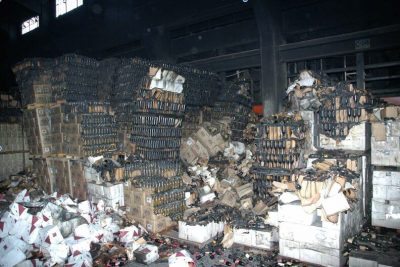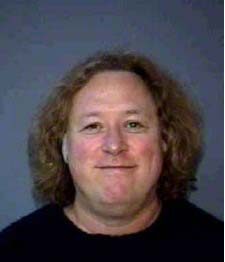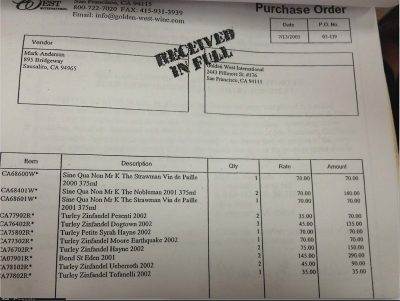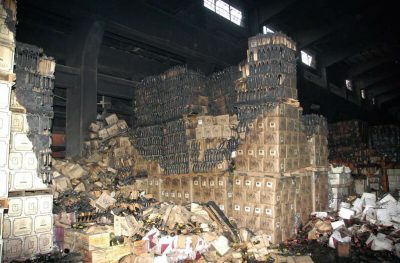Sausalito Wine Storage: Wine Central Arson
By Frances Dinklespel
Fire damage done in the Sausalito Cellars
Frances Dinklespel, investigative wine journalist shares yet another tale of a storage facility illegally selling client’s wines. But in this case, the owner tried to cover his tracks, with a potentially deadly fire.
On Oct. 12, 2005, during the height of the Napa Valley harvest, a fire broke out in a wine storage warehouse in Vallejo, Ca. and destroyed about 4.5 million bottles of fine wine worth $250 million.
When the flames died down and the wreckage cooled, investigators from the Bureau of Alcohol, Tobacco, Firearms, and Explosives combed through the building. The ATF’s firedog sniffed out the presence of a plumber’s propane torch and the remains of some gasoline-soaked rags on the mezzanine level of the 240,000-square foot building.
The fire at the Wines Central warehouse in Vallejo had been deliberately set, making it the largest crime involving wine in history. More than 95 private collectors and wineries were affected, including Long Meadow Farms, Saintsbury, Viader Vineyards, Venge Vineyards, Sterling Vineyards, Sean Thackrey, Robert Sinskey, Mario Andretti’s winery, and many more. Some wineries lost entire vintages. Others lost their wine libraries. A number were uninsured.
Mark Anderson
Federal prosecutors would spend the next seven years chasing the man they suspected of the crime: Mark C. Anderson, a businessman from Sausalito, CA, who ran a wine storage company that sublet space in the warehouse. Anderson was finally sentenced in February 2012 to a 27-year prison term for arson, fraud, interstate transfer of stolen goods, and falsifying income tax records. He is now incarcerated at Terminal Island, a federal penitentiary near Los Angeles.
Federal officials are not entirely certain why Anderson set the blaze, but they suspect he was trying to cover up his tracks. At the time of the 2005 arson, Anderson was facing numerous charges of embezzlement for allegedly stealing more than $1 million worth of wine from his clients at his wine storage business, Sausalito Cellars. ATF Agent Brian O. Parker and former U.S. Attorney Steven Lapham think Anderson burned down the Wines Central warehouse so he could say that his clients’ missing wine went up in flames.
Wine theft is a growing problem in the world of fine wine, fueled by the relative ease of selling over the Internet. The centuries-old gentlemanly culture that shies away from asking hard questions about the provenance of wine has also contributed to the growth of the black market for fine wines.
Receipt of Mark Anderson's Purchases
When Mark Anderson set up Sausalito Cellars in 1999, he had all of the credentials that would make potential customers trust him. He was civic-minded, serving on the boards of the Sausalito Parks and Recreation Commission and Arts Commission. He worked with the local Chamber of Commerce and Rotary Club and was a respected photographer who had exhibited in Sausalito’s well-regarded Art Fair.
Anderson, born in Berkeley, in 1948, learned to love wine just as the rest of America was rediscovering the Napa and Sonoma valleys. He would drive up to Napa in the late 1960s and early 1970s and pay 50 cents to fill up his empty jug at Old Man Pagani’s winery in Sonoma (the very same grapes that would later be used for a prize-winning Ridge Vineyards Zinfandel). Or he would visit Robert Mondavi’s newly constructed winery on Highway 29 where he often had the chance to chat with the legendary winemaker.
But it was his time in Asia that turned Anderson into a true wine lover. He fell in with a group of older Japanese businessmen who formed the Kansai Wine Club to taste the world’s best wines in exotic locales. Anderson said he drank wine inside the Great Pyramid, on a South Pacific atoll, and inside the private dining room of Hotel George V in Paris. Anderson used all the experiences to impress potential clients.
Fire damage done in the Sausalito Cellars_1
By 2001, Anderson had a full roster of clients, so many, in fact, that he had to expand Sausalito Cellars. It was around this time, according to Sausalito police, that he also discovered a new source of income: selling his customers’ wine. It wasn’t that hard. All Anderson did was contact a number of the San Francisco Bay Area’s wine retailers, including Golden West Wines in San Francisco and Premier Cru in Emeryville and offer wine for sale. The retailers didn’t ask provenance or ownership questions and gladly consigned the wine. Over a period of four years, Anderson sold thousands of cases of Burgundy, Bordeaux, California Cult Cabernet Sauvignon, and many other high-valued wines. He also earned a reputation as being the kind of guy that would bring great wine to any party.
In December 2003, one of Anderson’s clients caught on. Samuel Maslak had sent 756 cases of wine to store with Anderson while he sorted out the bankruptcy of his South San Francisco restaurant. When the legal issues were settled, Maslak returned to Sausalito Cellars for his wine. It wasn’t there. Anderson gave Maslak a convoluted explanation for the missing wine. Maslak went to the police.
The Marin County District Attorney charged Anderson with embezzlement in February 2004. As soon as the story hit the newspapers, more clients stepped forward to claim that wine was missing. One close friend of Anderson’s, Jack Krystal, the president of the local Food and Wine Society, discovered that a rare, large format bottle of 1959 Château Lafite-Rothschild worth $29,000 was missing.
Regardless of the negative publicity, Anderson continued to sell wine to various wine retailers. If the retailers questioned his right to sell the wine, Anderson backed off – and then approached again under an assumed name. No one caught on. Over a four-year period, police believe Anderson sold more than 8,000 bottles of wine worth more than $1 million to various resellers.
By October 2005, Anderson was facing multiple counts of fraud. Something snapped. A month earlier, he had gone to his computer and searched “cell phone triggers.” But it didn’t take a fancy electronic contraption to set the destructive Wines Central warehouse fire. All it took was a bucket full of gasoline soaked rags and a propane torch. He drove from his Sausalito apartment to the warehouse in Napa, walked to his storage area on the mezzanine, nestled the rags next to a pile of cardboard, and set the pile on fire.
The fire that erupted was so large and smoky that firefighters said it looked as if a 747 had crashed into the building.
Frances Dinkelspiel is a journalist and the author of Tangled Vines: Greed, Murder, Obsession and an Arsonist in the Vineyards of California, which will be published in October 2015. You can buy the book here.
http://us.macmillan.com/tangledvines/francesdinkelspiel
http://www.amazon.com/Tangled-Vines-Obsession-Vineyards-California/dp/1250033225



